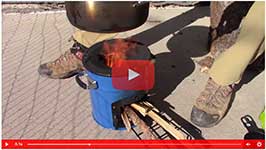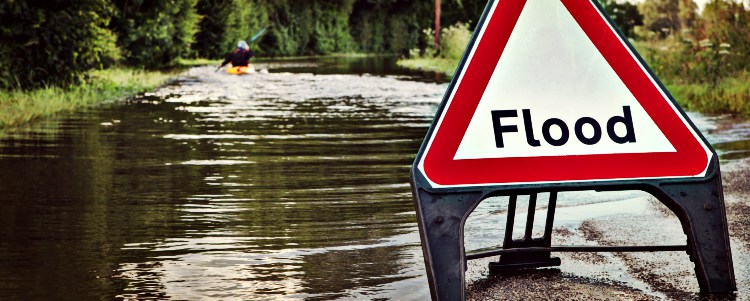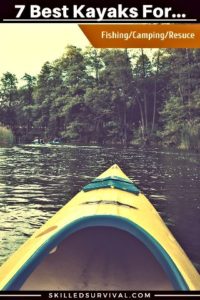
A Complete Guide To Finding (& Using A Kayak) The PERFECT Kayak
Because buying a kayak should NEVER be an impulse purchase.
For example:
Just because you see one on “sale” at a big-box retailer doesn’t mean it’s right for YOU.
- Maybe you’re looking for a damn good fishing kayak
- Perhaps you want one to use as a rescue vehicle in a future floodwater emergency
- Maybe you’re interested in using a kayak for epic backcountry camping trips
- Or perhaps you’ve been thinking about using a kayak as a bug-out vehicle…
But regardless of the type, I’ve got you covered…
TOPICS IN THIS GUIDE… ↓(click to jump)
- Why You Should Invest In One
- Different Types Of Kayaks
- Best Kayaks For Sale Today
- Loading and Storage Options
- 8 Fundamental Kayak Strokes
- Keeping Kayak Gear Clean & Dry
- How To Navigate On Water
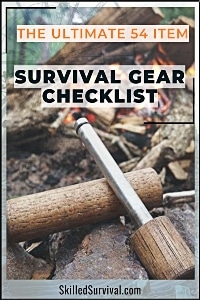
Want a free 54 item survival gear checklist?
Enter your email below to instantly download this Complete Checklist PDF. No purchase necessary. 👇 👇4 Reasons Why You Should Invest In One
1. Recreation / Fun
The number one reason why anyone gets a kayak is they’re fun!
Long days on the water are one of the most enjoyable ways to spend time in the outdoors.
Whether it’s a pristine lake, calm sea, or extreme rapids, they’re a freakin’ blast!
I mean, it would be such a shame to get one and never use it.
So make sure you carve out time on the water every year. And take your kayak out of the garage and out on the water.
2. Remote Camping
With the right kayak, you can go beyond day trips out on the water to overnight excursions.
You can take a lot of essential camping gear with you without carrying everything on your back.
I know many people who love the feeling of freedom and remoteness backpacking provides.
But they don’t want to hike 10+ miles with 35 lbs. of gear on their back.
So they’ve taken up overnight kayak trips instead.
It allows you to escape into the REAL wilderness without breaking your back.
3. Fishing
Kayaks are becoming more popular among anglers.
Why? Because they are an incredibly lightweight alternative to the traditional aluminum Jon Boat.
I don’t relish the days of yesteryear struggling to maneuver my father’s Jon Boat in and out of the water.
Instead, with a kayak, you get much of the same fishing experience with much less hassle.
You can even go extremely lightweight with an inflatable fishing boat!
Nowadays, many inflatable kayak models are designed with fishing in mind from the ground up.
4. Emergency Rescue Device
We’ve all heard the term “up sh*t creek without a paddle.”
And typically, this famous “saying” is used to describe all sorts of bad situations – not just water-related ones.
Unfortunately, it often becomes a reality in flooding emergencies!
Did you know that the most deadly natural disasters usually involve flooding in the US?
On average, U.S. flooding kills more than 100 people a year — more than any other single weather hazard, including tornadoes and hurricanes, according to the University Corporation for Atmospheric Research (UCAR).
For example, hurricane-induced surges and rain caused unprecedented urban flooding in Houston and New Orleans.
Rising waters swamped homes, decimated businesses, and shut down entire cities.
Not to mention all the chemicals, fuel, sewage, and other dangerous pollutants that are dumped into the rising water.
Many people became instantly trapped, waiting around for rescue.
But those who owned small floating vessels were far better off in the immediate aftermath.
Why? Because they could evacuate, search for supplies, and move around as needed.
But, even much less dramatic flooding happens all across the nation – wreaking disruptive havoc and dangerous conditions.
It only takes a couple of feet of water to cause roads to be impassible for cars, SUVs, and trucks.
For example, during a recent flood in my hometown, the police asked for civilian help.
They needed anyone with boats to evacuate a neighborhood due to just 18 inches of floodwater.
Kayaks, canoes, and small fishing boats saved the day.
It allowed them to get to dry land and move on with their lives until the water receded.
5. Stealthy Bug Out Transportation
A small, discrete boat can get you off the streets and away from crowds in a worst-case emergency scenario.
Moving away from danger to safety is called “bugging out.”
And even the tallest, bulletproof bug-out vehicle can’t overcome deep, dangerous floodwaters. But a kayak can.
It’s a quiet boat that requires no fuel and leaves no tracks behind.
- It slips stealthily through shallow water and floating vegetation.
- You can easily haul it up on shore when you reach a safe camp.
- It can be easily hidden from view by others on the water during a rest stop.
If you want the ultimate in stealth capability, look into duck-hunting setups.
These kayaks become floating blind, camouflaged with netting and woven vegetation.
A well-concealed floating blind can hide you from your prey and anyone who might be hunting YOU!
↓ My Kayak Hunting Blind Setup
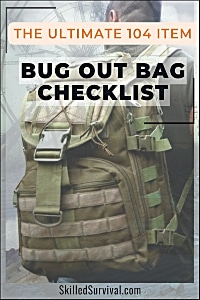
Want a free 104 item bug out bag checklist?
Enter your email below to instantly download this Complete Checklist PDF. No purchase necessary. 👇 👇5 Types Of Kayaks You Can Choose
The right kind of kayak for YOU depends upon the following:
- the type of water you’ll be using it on
- how you plan to use it (whitewater, lake, fishing, bugging out)
- how much equipment do you want to bring along
Here’s the deal:
Thousands of unique kayaks are on the market today (making research overwhelming).
But the good news is – they all tend to fit into just a few categories.
So, if you can figure out which type you want, you’ll be able to focus on the right one fast.
Here’s a video that goes over each option in detail (or you can read more about each category below):
↓ Kayak 101: Differences Between Kayak Designs
1. Whitewater Kayaks
We’ve all seen videos of extreme kayakers dropping 100+ foot waterfalls and surviving.
Chances are they’re in a very specialized whitewater craft.
These are highly reinforced, extremely durable boats.
But they’re not designed for much more than running whitewater rapids.
Why? Because They’re small (up to 7 feet long), have very little storage, and are not very comfortable in the long term.
Whitewater kayaks require advanced paddling techniques and a lot of focused training.
So this is NOT for you – unless your plans include “extreme sports,” and you can accommodate these drawbacks.
Otherwise, you don’t “need” these capabilities, and a whitewater kayak is NOT the type that’s best suited for you.
2. Inflatable Kayaks
If your plans include some lake fun, gentle whitewater (not huge rapids), and fishing, then an inflatable kayak is your best bet.
These 10′-14′ foot boats are designed and built the same way as whitewater rafts, except they include several durable inflatable chambers.
These inflatable chambers provide the main structure and floor of the boat.
Most are also self-bailing, so any water that splashes in can drain out the bottom.
You can load your gear in waterproof drybags and lash it down in the bow and stern.
And, best of all, they can be inflated when needed and deflated when you’re off the water!
3. Touring Sea Kayaks
Traveling long distances in open water (whether at sea or on big lakes), a touring sea kayak is likely your best option.
These boats are designed for efficient paddling and covering distances quickly.
The sit-inside design keeps your center of gravity low, which helps to prevent tip over.
Sitting low also helps to keep your lower body protected by a spray skirt.
A spray skirt is a waterproof cockpit cover that fits snugly around the waist.
Many models have:
- integrated flotation
- gear tie-downs on the deck for small, frequently accessed items
- sealed cargo hatches over large internal gear compartments
The long (16′ foot and up) and narrow profile make them easily cruise through the water.
And the retractable rudders and skegs keep you tracking straight toward your destination.
One drawback of gear compartments is that everything has to be able to fit through a small hatch.
So you’ll have to figure out how to pack your boat efficiently to ensure everything fits.
4. Surfing Kayaks
Most touring sea options do well with smaller surf.
But not if your coastline has some bigger gnarly waves.
In such cases, a surf kayak is ideal for handling and piloting successfully through large breakers – which is vital when launching and landing in rough seas.
These feature a hull design that’s more agile than a touring boat.
But it still maintains some cargo holds, which are lacking in a traditional whitewater boat.
Again, these are more specialized models and require specific training and techniques.
So don’t expect to pick one up and be a pro the next day.
5. Recreational Sit-On-Top Kayak
Finally, a recreational sit-on-top is one of the most versatile types.
These have similar durability and use rotomolded plastics (similar to whitewater boats).
However, the paddler sits on top rather than sitting down inside the kayak.
That’s because the seat is molded directly into the boat’s upper deck.
Now, this seat location does have its drawbacks.
For example, it’s not nearly as stable as other styles, so they are best suited for calm waters.
However, the seat location does make getting in and out of the boat a breeze.
More extensive models feature internal cargo compartments with waterproof hatches.
They also include cargo areas to lash down drybags on deck; some can even carry hundreds of pounds of gear.
There are some models with accessory attachment points.
These attachment locations are ideal for adding a small electric trolling motor and fishing rod holders!
Note: Most fishing kayaks are of the “sit-on-top” variety. I’ve also seen a few decent inflatable kayaks used for fishing as well.

Want a free 54 item survival gear checklist?
Enter your email below to instantly download this Complete Checklist PDF. No purchase necessary. 👇 👇Best Kayaks On The Market Today
So, what’s the best kind for you?
It depends a lot on your specific usage plans.
But versatility, durability, and ease of use are all things to keep in mind.
Here are a few of the best-rated models out there and what makes them stand out:
The Wilderness Systems ATAK is a stable kayak fishing platform with many modern features.
It's stable enough to stand up but still agile for paddling.
It has a suspension seat and large padded foot braces to keep you comfortable while paddling.
The storage options are great, including a live well for fish!
PROS
- Stern and center mount storage
- Great, comfortable seat
- 400lb cargo and paddler capacity
CONS
- Expensive
- Heavy
↓ Wilderness Systems ATAK 120 Review
Perception has been in the business of making kayaks for a long time, and this one lives up to its quality name.
The Perception Pescador 10 is a sit-on-top fishing kayak designed to be one of the best kayaks for the money.
This kayak includes a large open storage area, a covered dry storage box, plus two individual rod holders.
It also includes multiple gear tracks and Solo Mount recesses to make adding lots of fishing accessories extremely easy.
PROS
- Convenient seatback positioning
- Quick-adjust footrests
CONS
- Not as much storage space as in other models
- Gear mount rails are not as good as other models
↓ Perception Pescador Recreational Kayak
Old Town is one legendary canoe and kayak maker.
They've spent a century building a reputation for quality and craftsmanship.
This Topwater is a purpose-built fishing kayak.
But the features that make it well suited to that task also make for an excellent bug-out boat.
It has scupper holes to allow water to drain out the bottom.
But the standout here is the pedal drive.
Maneuvering the boat forward and backward WITHOUT putting down the rod is a major bonus!
This feature also makes this kayak ideal for those with limited arm strength or mobility.
PROS
- Stable platform
- Great storage and mounting options
- Comfortable deck pads and seat
- PEDAL DRIVE!
CONS
- Very expensive
↓ New Old Town Topwater Fishing Kayak!
Lifetime is a newer brand on the kayak market, but they make quality sit-on-top kayaks at a reasonable price point.
The Tamarack Angler is a stable fishing kayak platform boat.
But it doesn't have all the storage options that more expensive models offer.
Yet, this can be overcome with a good set of dry bags and some proper packing.
PROS
- Inexpensive
- Quality gear lash-down points
- Lightweight
CONS
- Limited internal storage
↓ Lifetime Tamarack Angler Kayak Review & Modification
At only 28 lbs, this inflatable kayak is perfect for those who want mobility both ON and OFF the water.
When rigged as a single-person boat, it has more than enough storage for gear lashed down in drybags where a second person would normally sit.
PROS
- Lightweight
- Can be packed small for storage and transportation
CONS
- Can be punctured
- Challenging to pack down into a case
The Pelican Argo 100XP is another budget-friendly fishing kayak.
First off, this fishing kayak has ergonomic carrying handles, making hauling this relatively light 41 lbs unit a breeze.
You'll also be thankful for its adjustable footrests and Ergofit G2 Seating System.
This means it has an adjustable and ergonomically padded backrest and seat cushion.
Anyone who's spent a lot of butt time in a kayak will appreciate it.
The multi-chine flat bottom hull offers excellent stability, which is great for fishing.
As far as storage options go - it has a convenient front Quick-Lock hatch and a rear hatch with a storage bag.
It also has an open rear tank well that's equipped with a mesh deck cover.
So with all these storage options, you'll have plenty of room to bring along all your most critical gear.
Finally, this Pelican Argo comes with a cockpit table with compartments, a smartphone holder, and a bottle holder built into the seat to keep things within easy reach.
PROS
- Budget-Friendly compared to models with similar features
- Decent overall storage options
- Lightweight kayak (41 lbs)
- Comfortable seat
CONS
- Limited amount of internal "hatch" storage options
↓ Pelican Argo 100 Angler Kayak Review

Want a free 54 item survival gear checklist?
Enter your email below to instantly download this Complete Checklist PDF. No purchase necessary. 👇 👇Expert Advice On Gear Loading and Storage
One of the best parts of any boat trip is letting the boat take the load rather than your back.
You can bring heavier items and some luxuries that would never fit in a backpack (such as a lightweight camp table).
Many kayaks, including the paddler, have load ratings in the 300-500lb range.
This extra capacity leaves you with several hundred pounds of gear storage (fishing, camping, or survival gear).
And when you get off the water at the end of the day, you’ll still have fresh legs and not a sore back!
Think of kayak camping as car camping, but away from the vehicles!
Of course, you still need to load your boat correctly to keep it balanced and stable.
There are a lot of options for loading.
But generally, try to keep the heavy items low in the boat and towards the center.
This loading technique goes for both front-to-back and side-to-side storage.
If you do this right, it will help keep you from tipping while maintaining maneuverability.
Each boat design is different, so it’ll take some practice to see how everything fits.
I recommend starting with smaller loads and spending a couple of hours on the water to test it out.
Then move up to weekend trips to shake down your gear and skills.
Taking shorter trips will also allow you to learn the paddling skills needed for your boat.

Want a free 54 item survival gear checklist?
Enter your email below to instantly download this Complete Checklist PDF. No purchase necessary. 👇 👇8 Fundamental Kayak Strokes & Maneuvers
There are several basic paddle strokes and rudder/skeg controls you should learn.
Because paddling more efficiently will help you with maneuverability and endurance in any situation.
You can learn a lot online and take those skills to shallow, calm water for practice.
But always have a friend or an instructor to help you in case of an emergency.
1. Forward Stroke
The forward stroke is the most used of all the strokes; you’ll be using it ALL THE TIME.
That’s why you’ll need lots of endurance in these arm muscles and a lot of power to keep forward motion.
You also need solid core and back muscles to do the heavy pulling that powers the stroke.
You’ll want to keep upright and brace your foot and knee.
Maintaining the correct body position helps with both balance and efficiency.
↓ The Proper Forward Stoke For All Kayakers
2. Reverse Stroke
The opposite of the forward stroke is the reverse stroke.
The reverse stroke technique is essential to stop you in an emergency.
It requires many of the same muscles, just applied in the opposite direction.
It means pushing instead of pulling and rotating your hips and shoulders in reverse.
↓ The Back | Reverse Storke – Sea Kayak Technique
3. Sweep Stroke
The sweep stroke allows you to apply a full, wide turn without a rudder.
It’s like the forward stroke, but with the paddle extended further out away from the boat to pivot.
The sweep stroke can affect a quicker turn when applied with a rudder.
↓ Sweep Strokes – How To Paddle Series
4. Draw Stroke
Draw strokes allow you to move your boat straight to the side.
It’s particularly useful when you want to tie several boats together.
Because tied together, kayaks allow for more comfortable conversations or even enjoying a communal lunch on the water.
But the stroke is just as necessary when you’re pulling up alongside a dock or steep riverbank landing.
↓ Kayak Technique – Draw Stroke
5. Rudder Stroke
The rudder stroke is useful to keep control over the direction you’re heading.
Unlike the other strokes, the rudder stroke ends with the paddle blade, giving you indirect control over the gliding path forward between strokes.
If you plan to surf or whitewater, you’ll need to use the rudder stroke.
It allows you to maintain control without spending all your energy course correcting.
In fact, you can even use it if the wind is at your back and propelling you along without paddling.
↓ The Stern Rudder Technique
6. Edging
Edging is a maneuver that allows you to tilt your kayak slightly to one side.
This maneuver lets the curve of the hull act in a carving turn.
The key is to learn the balance point of your boat and not over-rotate until you capsize.
↓ How To Edge And Lean A Kayak
7. High/Low Brace
Bracing is an emergency maneuver.
It helps you correct the momentum of a boat that has rolled past its tipping point.
It’s the first step in recovering a tipping boat.
Bracing is also the primary technique for rolling up a capsized kayak.
Remember that it puts a lot of force on your shoulders and can cause injury if done incorrectly.
The difference between high and low braces is in hand and paddle position, but the purpose is the same.
↓ Kayak High Brace – How To Paddle Series
8. Self Rescue (if it flips over)
Finally, what if the high/low brace doesn’t work and you flip?
Well, you’re now in the territory of a self-rescue…
This is one technique you should master before you stray too far away from shore – as it could save your life.
In freezing cold water temperatures, you won’t have enough time to swim to shore – unless you’re very close.
So you’ll need to get back into your kayak and out of the water fast.
Here’s a video showing you how:
↓ How To Self-Rescue In A Kayak

Want a free 54 item survival gear checklist?
Enter your email below to instantly download this Complete Checklist PDF. No purchase necessary. 👇 👇How To Keep Your Gear Clean and Dry
No matter what kind you choose, it’s imperative that you keep all your gear dry and safe from water.
Saltwater is a big concern for corrosion – since salt is highly corrosive.
But even freshwater can ruin your tools, food, sensitive/expensive electronics, and ammunition.
Hard cases (Pelican) and dry bags are the first lines of defense.
Pack all your gear in waterproof containers and double-wrap the critical stuff.
I like to line dry bags with heavy-duty trash bags, just in case a slight leak makes it into the outer bag.
Heavy-duty Ziploc bags are also invaluable inside the larger packs.
This helps to keep critical maps, batteries, and other supplies dry even if the compartment becomes swamped.
Quick Note On Navigating On The Water
While you may have a great sense of direction on land, losing your bearings on the open water is easy.
That’s why it’s crucial to practice navigation on waters you know well first — with a map/chart and compass.
Your GPS may be great (and should be your primary navigation tool), but it’s useless if it gets dumped overboard.
Ensure your compass skills are up to the task, so you’re not stuck on the water with no backup plan.
It won’t take long to become familiar with picking out navigation landmarks from the water.
You’ll discover that these techniques are like navigation on land.
Final Thoughts
Kayaks are a fun, versatile, efficient mode of transportation in all sorts of situations.
They allow you to cover marathon distances or cross murky waters with ease.
So if your idea of fun includes water travel, a kayak is a wise option to have at your fingertips.
It’s stealthy, discrete, and can carry a ton of gear and supplies without putting a strain on your back.
Think about how they can fit into your life and give one a try – you might find they’re your perfect bug-out vehicle!
Why Trust Skilled Survival...
Go here now to review a full breakdown of:
- Who We Are
- Our Credentials
- Our Mission
- & Product Recommendations...
Here are a few highlights of our teams credentials & certifications:
- Certified Member of a Mountain Search & Rescue Organization
- Plant Emergency & Safety Leader for a Major Food Manufacturer
- Member of the 10TH Mountain Division Hut Association
- Certifications: Avalanche 1, WFR, CPR
- Official Gear Tester for Numerous Outdoor Gear Companies
- Countless Multiday Backpacking trips into Remote Wilderness
- Bachelor's Degree In Mechanical Engineering
- Bachelor's Degree In Civil Engineering
- Bachelor's Degree In Biomedical Engineering
"It takes 20 years to build a reputation and five minutes to ruin it." - Warren Buffett
We're fully aware that trust is NOT something you GET but is EARNED.
And we'll continue to earn YOUR trust through our forthright and honest approach with each new Blog Post, Guide & Product we create...
Prepare, Adapt & Overcome,

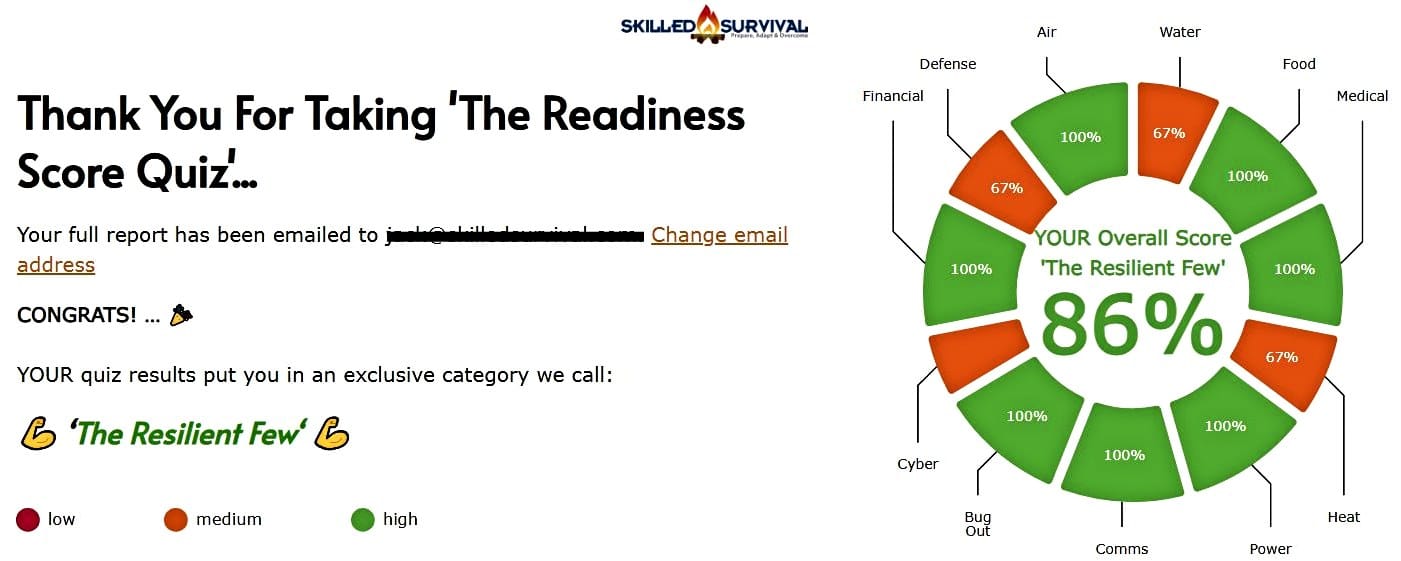
AND... I've still got a few gaps in my preps...🤔 But at least, I'm not part of 'The Fragile Masses'. 👍 Find out where YOU stand by answering a few questions...
